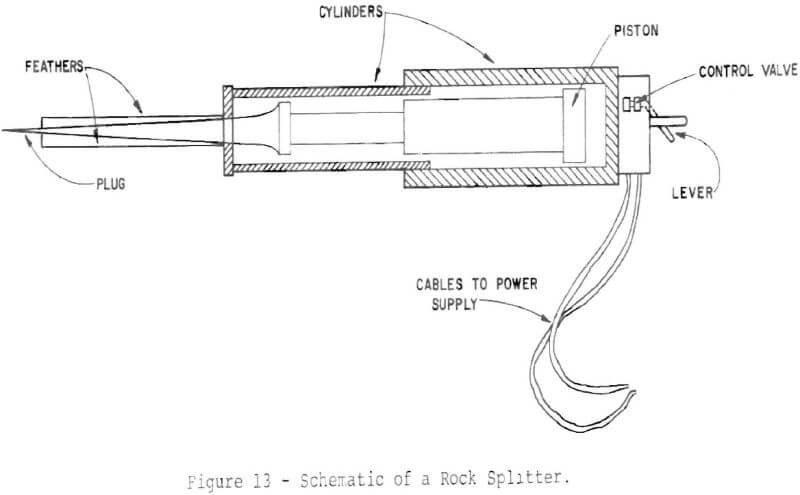Rock splitting utilizes a tensional force to crack the rock. This is achieved by inserting a split steel shank in a drillhole and driving a steel wedge between the center of the split shank thereby producing the tensile forces.
The advantages of the rock splitting technique over blockholing are the absence of explosives and the reduction of downtime provided there is quick and easy access to the rock splitting equipment.
The rock splitting technique does have some disadvantages. Drilling the required hole is time consuming and hazardous. Before any drilling is done, the boulder should be examined for stray powder and for the best hole location. The boulder, probably containing cracks from the primary blast, will be hazardous to drill in that, it could split without warning. When actually splitting the rock with the splitter, a safe place on the boulder must be available to work from so as to avoid injury. Alternatively the procedure may be done by remote control whereby the operator is removed from the breaking area.
One type of rock splitting machine is illustrated in Figure 13. This hand held device utilizes hydraulic pressure to expand a plug placed in a drillhole creating tensile failure in the rock. The upper cylinder contains a piston which exerts force upon a wedge-shaped plug in the lower cylinder. The plug is pushed between two tapered bars or “feathers” causing them to expand outward and exert pressure against the drillhole wall. Operating pressure is 7,000 psi and splitting force can be from 176 to 410 tons depending on the size of machine used. This machine is generally used where blasting is not permitted.

Because no explosives are used, blasters licenses are not needed, magazine storage is not necessary, and excessive flyrock is not created except for small fragments which may fly tens-of-feet upon rock splitting. In addition to the disadvantages mentioned for drilling boulders, the method requires a critical hole depth, which if too shallow, will break off the “plug” during expansion of the “feathers”. Consequently the employee is in a dangerous position when drilling the access hole, and is again endangered when changing equipment to use the splitter which prolongs the employee’s exposure to the possible hazards.
Use of the Rock Splitter requires the drilling of a 1-3/16 to 1¾ in diameter hole, of at least 12 to 26 in deep depending on the model used. The procedure then requires the placement of the splitter in the hole and oriented towards the desired direction for splitting. The control lever is then activated and splitting should occur within 10 to 60 seconds.
